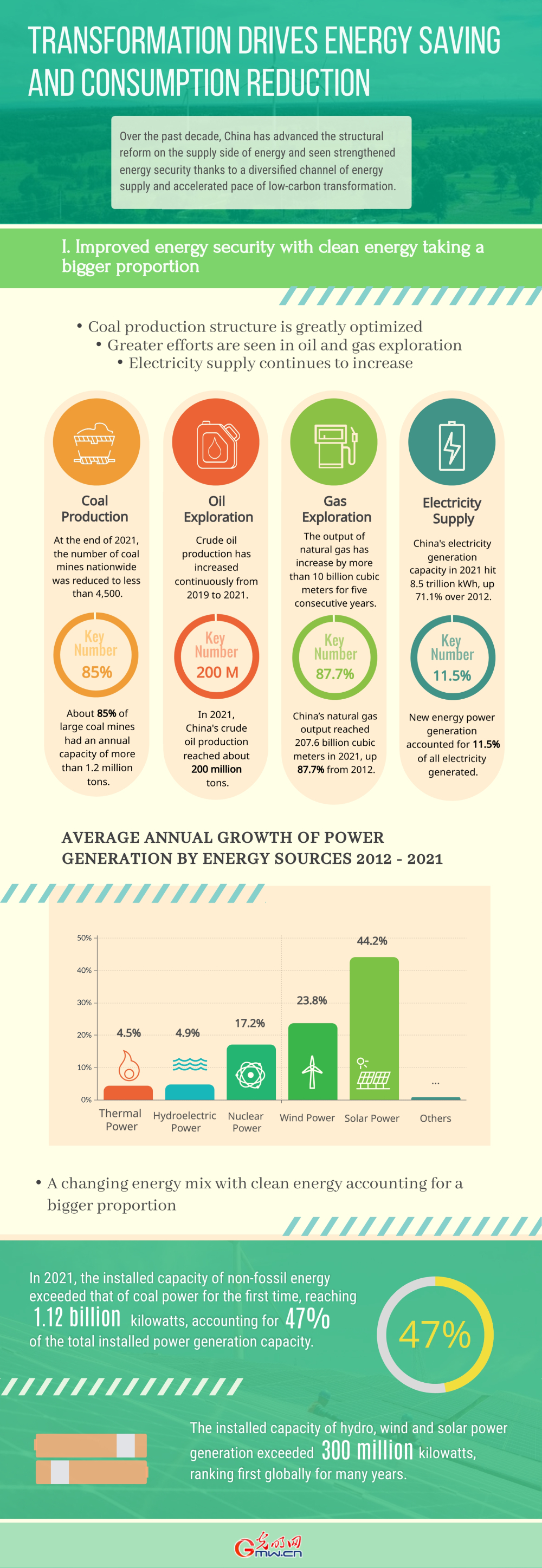China in a Decade: Transformation drives energy saving, consumption reduction
 0 Comment(s)
0 Comment(s) Print
Print E-mail GMW.cn, October 25, 2022
E-mail GMW.cn, October 25, 2022
Since the 18th CPC National Congress, with the advance of the structural reform on the supply side of energy, China's energy security has been strengthened thanks to a diversified channel of energy supply and accelerated low-carbon transformation. Moreover, remarkable progress has been made in recent years in energy efficiency and energy consumption reduction.
I. Improved energy security with clean energy taking a bigger proportion
Since the 18th Party Congress, China has actively expanded its energy supply through structural reforms and diversifying the provision of multiple forms of energy. China has prioritized the development of renewable energy, promoted the clean and efficient utilization of coal, and increased oil and gas exploration. Supply capacity is constantly enhanced, and the process of clean energy production has accelerated.
1. Coal production structure is greatly optimized
At the end of 2021, the number of coal mines nationwide was reduced to fewer than 4,500, the output of large coal mines with an annual capacity of more than 1.2 million tons accounted for about 85%, and main producers were concentrated in Shanxi, Shaanxi and Inner Mongolia. Production of raw coal has grown for five consecutive years since 2017, and coal output exceeded the historical high of 3.97 billion tons in 2013 and reached 4.13 billion tons in 2021.
2. Greater efforts in oil and gas exploration
Thanks to the "Seven-Year Action Plan" on increasing oil and gas production, crude oil production has increased continuously from 2019 to 2021, reaching about 200 million tons. The output of natural gas has increased by more than 10 billion cubic meters for five consecutive years from 2017 to 2021. China's natural gas output reached 207.6 billion cubic meters in 2021, up 87.7% from 2012, with an average annual growth of 7.2%.
3. Electricity supply continues to increase
As of the end of 2021, the total installed power generation capacity had reached 2.38 billion kW, 1.1 times higher than that of 2012, with an average annual growth of 8.4%. Electricity generation capacity in 2021 hit 8.5 trillion kWh, up 71.1% over 2012, with an average annual growth of 6.1%. Among them, thermal power increased 49.1% over 2012, with an average annual growth of 4.5%; hydroelectric power increased by 53.5%, with an average annual growth of 4.9%; nuclear power increased by 3.2 times, an average annual growth of 17.2%; wind power increased by 5.8 times, an average annual growth of 23.8%; solar power increased from 25.1 billion kWh in 2014 to 325.8 billion kWh in 2021, an increase of 12.0 times, an average annual growth of 44.2%. New energy (wind, solar and other new energy) power generation increased by 6.8 times, with an average annual growth of 25.7%, accounting for 11.5% of all electricity generated, up 9.0 percentage points over 2012.
4. A changing energy mix with clean energy accounting for a bigger proportion
In 2021, the installed capacity of non-fossil energy exceeded that of coal power for the first time, reaching 1.12 billion kW, accounting for 47.0% of the total installed power generation capacity. The installed capacity of hydro, wind and solar power generation exceeded 300 million kW, ranking first globally for many years.







Go to Forum >>0 Comment(s)